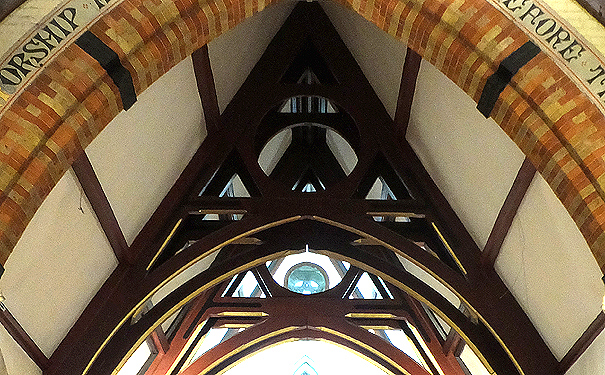 |
 |
In church architecture, the chancel is at the east end of a church building, and comprises the choir and sanctuary. The word chancel comes from the Latin cancellus meaning lattice, describing the screen that during some eras of church history divided the chancel from the nave. It is the part of the church, where the service is conducted, as distinct from the nave, where the congregation sits.
 The choir, also sometimes called quire, is at the start of the chancel (looking from the nave), before reaching the sanctuary. It begins at the eastern side of the central crossing, under an extra-large arch supporting the crossing and the roof. 'O COME, LET US WORSHIP AND FALL DOWN AND KNEEL BEFORE THE LORD OUR MAKER' is written on the arch.
The choir, also sometimes called quire, is at the start of the chancel (looking from the nave), before reaching the sanctuary. It begins at the eastern side of the central crossing, under an extra-large arch supporting the crossing and the roof. 'O COME, LET US WORSHIP AND FALL DOWN AND KNEEL BEFORE THE LORD OUR MAKER' is written on the arch.
As an architectural term "choir" remains distinct from the actual location of any singing choir but at St James’s members of the singing choir do sit here when they are present. They sit in the Choir Stalls which are fixed seats arranged in two rows on each side, facing each other. The stalls are made of wood and the ends are beautifully carved. This area also provides seating for the clergy and servers at most services.
The choir roof beams, in the shape of an A and O, Alpha and Omega, the first and last letters of the Greek alphabet, remind us that God is the beginning and the end of everything. There are various corbels (carved stone supports) on the choir walls, including the heads of the Virgin Mary, on the north side, and St James, on the south side. They, and more, can be seen on the page Stonework and Tilework in the Chancel.
The Organ is also situated on the north side of the choir and is now a three manual and pedal organ containing hundreds of wooden and metal pipes of different sizes. The interior of the instrument, where all the pipes are situated, is hidden behind the console.
There is only one stained glass window in the choir, on the north side, representing St John the Evangelist. Find out about The Chancel Stained Glass Window.
The sanctuary is at the east end of the church, separated from the choir by a step and a brass rail supported on carved stone and marble pillars. The sanctuary is the most sacred part of the church around its high altar. Find out about The High Altar and its Reredos. The stonework and tilework can be seen on the page Stonework and Tilework in the Sanctuary.
There is a beautiful stained glass window above the high altar in the sanctuary and a sedilia (two stone canopied seats). To see all these windows, more detailed pictures and information about them look at the page The Sanctuary Stained Glass Windows.
There are two special clergy chairs, sometimes called bishops chairs, at the front of the choir and also two in the sanctuary. They are made of wood and ''IHS' is carved on the backs of three, with another chair having the carving ‘Whatsover thy hand / findeth to do / do it with all / thy might / Ecclesiastes IX V10)’. 'IHS' stands for the first three letters of the Greek for Jesus (ΙΗΣΟΥΣ) - perhaps this was intended for the Bishop when he visited? There are also two litany or prayer desks for the clergy in the choir, also made of carved wood. Originally they were where the minister knelt, while reciting the litany. Find out about the Bishop Chairs and Litany Desks.
The alms dish or collection plate stands to the left of the sanctuary. It is inscribed 'All things come of thee and of thine own have we given'. In the north sanctuary wall there is a decorated Niche.
The credence table stands to the right of the high altar. It was gifted to the church in 1967 in memory of Amy Lush and Stephen Forrow. It is used to stand the chalices and pattens on during Parish Communion.
Find out more
 |
 |
 |